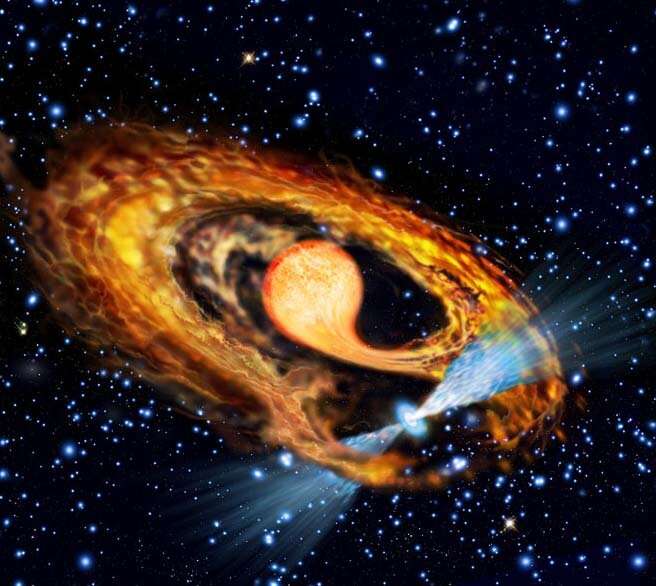June 21, 2021 report
Astronomers inspect the formation of millisecond pulsar PSR J1946+3417

A team of Chinese astronomers has conducted a study aimed at inspecting formation scenarios for the millisecond pulsar PSR J1946+3417. They found that the pulsar was most likely formed as a result of a phase transition. The research was published June 10 on the arXiv pre-print server.
Pulsars are highly magnetized, rotating neutron stars emitting a beam of electromagnetic radiation. The most rapidly rotating pulsars, with rotation periods below 30 milliseconds, are known as millisecond pulsars (MSPs). Astronomers assume that they are formed in binary systems when the initially more massive component turns into a neutron star that is then spun up due to accretion of matter from the secondary star.
PSR J1946+3417 is an eccentric MSP (eMSP) with a spin period of 3.17 ms. It consists of a neutron star about 80 percent more massive than our sun and a white dwarf with a mass of approximately 0.266 solar masses. The system has an orbital period of about 27 days and orbital eccentricity at a level of 0.134.
Such high eccentricity of PSR J1946+3417 challenges current MSP formation theories, therefore a team of astronomers led by Long Jiang of the Xinjiang Astronomical Observatory in China decided to perform simulations in order to find the most plausible scenario that could explain the origin of this source.
"Employing the stellar evolution code MESA, we simulated the evolution of its progenitor," the researchers explained.
The team managed to simulate the evolution of the progenitor of PSR J1946+3417. According to their model, the neutron star had an initial mass of around 1.4 solar masses and the companion was a main-sequence star about 60 percent more massive than the sun. Afterward, the binary, which has an initial orbital period of approximately 2.59 days, evolved into a post-low-mass X-ray binary system (post-LMXB).
Based on the obtained data, the astronomers propose that formation and evolution of PSR J1946+3417 may be explained by the so-called phase transition (PT) from neutron star (NS) to strange star (SS). This process may occur when the core density of accreting NS in an LMXB system reaches the critical density for quark de-confinement.
The authors of the paper concluded that the phase transition hypothesis is the most plausible one that could explain the current properties of PSR J1946+3417.
"The results show that the PT scenario can reproduce the observed orbital period and eccentricity with higher probability then other values," the scientists wrote in the study.
They added that two other eMSPs, designated PSR J1618−3921 and PSR J0955−6150 probably experienced evolutionary processes similar to PSR J1946+3417. However, further studies are required in order to confirm this assumption.
More information: A Strange Star Scenario for the Formation of Eccentric Millisecond Pulsar PSR J1946+3417, arXiv:2106.05717 [astro-ph.HE] arxiv.org/abs/2106.05717
© 2021 Science X Network





















